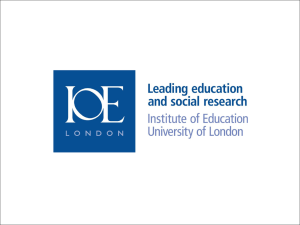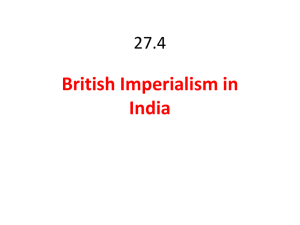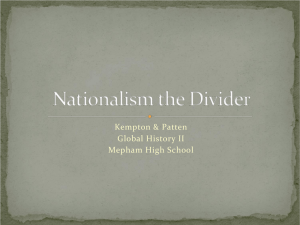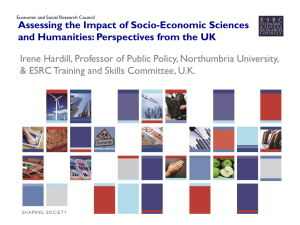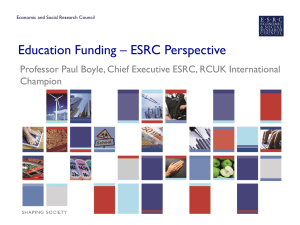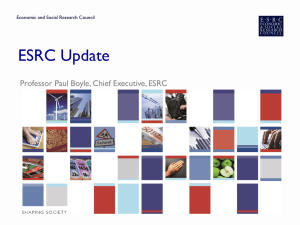Ethnicity and occupational mobility: trends since the 1970s
advertisement
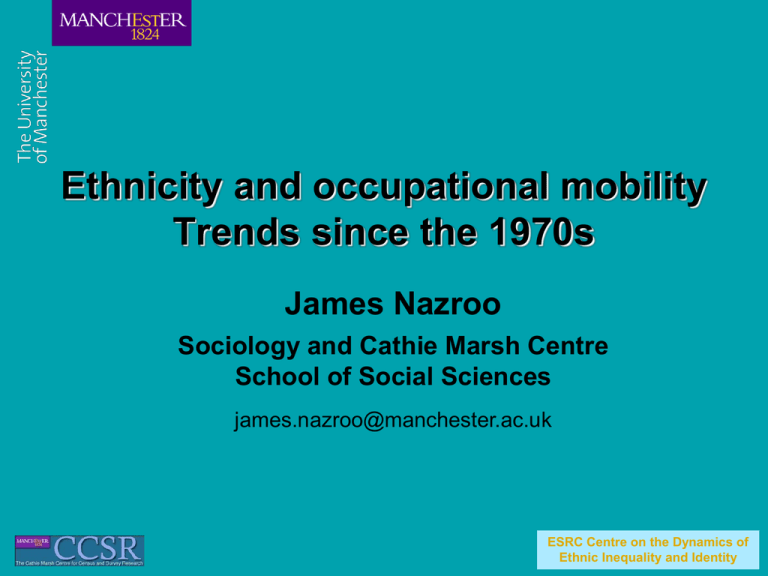
Ethnicity and occupational mobility Trends since the 1970s James Nazroo Sociology and Cathie Marsh Centre School of Social Sciences james.nazroo@manchester.ac.uk ESRC Centre on the Dynamics of Ethnic Inequality and Identity Key issues Marked ethnic inequalities in socioeconomic position. But pattern has varied over time, with evidence of improvements for some, but not all, groups. The importance of education (for mobility): The possibility that ethnic differences in orientation to education (cultural capital?) have led to different patterns of class mobility. The likelihood that success in education relates to others’ perception of ethnic categories – the ways in which we are racialised (or not). Evidence that for a given level of education ethnicity remains important, other ‘hazards’ associated with ethnicity play a role. The role of ‘structural’ processes leading to ethnic disadvantage (indirectly observed by identifying the extent of an ‘ethnic penalty’): Class origin; Access to education; Institutional and interpersonal discrimination. ESRC Centre on the Dynamics of Ethnic Inequality and Identity A brief summary of methods A focus on inter- and intra-generational mobility. Class, education (and income inequalities), comparing unrelated first and second generations (using the Health Survey for England). Intra-generational mobility in occupational class and employment across periods (using the Longitudinal Study (LS)). And differences across cohorts (inter-generational) (using the LS). The role of education (Lucinda Platt’s work using the LS). Mainly examining relative rates (to white British/English group) that do not directly address changes in occupational structures. A complex picture: Varying ethnic/religious groups included in the analysis (data restrictions and focussing on key issues). But try to keep some attention on important detail. Summary of important gender differences. ESRC Centre on the Dynamics of Ethnic Inequality and Identity Class mobility, unrelated generations IV/V IIIm/nm I/II 100% 90% 80% 70% 60% 50% 40% 30% 20% 10% 0% 1st 1.5/2nd Black Caribbean 1st 1.5/2nd Indian 1st 1.5/2nd Pakistani 1st 1.5/2nd Bangladeshi Smith, Kelly and Nazroo, 2009 1st 1.5/2nd Chinese 1st 1.5/2nd Irish ESRC Centre on the Dynamics of Ethnic Inequality and Identity Educational mobility, unrelated generations No recognised qualification NVQ1 NVQ2 A level equivalent Higher Ed < degree Degree equivalent 100% 90% 80% 70% 60% 50% 40% 30% 20% 10% 0% 1st White 1.5/2nd Black Caribbean 1st 1.5/2nd Indian 1st 1.5/2nd Pakistani 1st 1.5/2nd Bangladeshi Smith, Kelly and Nazroo, 2009 1st 1.5/2nd Chinese 1st 1.5/2nd Irish ESRC Centre on the Dynamics of Ethnic Inequality and Identity Period and cohort effects: odds of manual occupational class compared with white British Men 10 16.2 1 1971 cohort 1971 cohort in 2001 2001 cohort 0.1 Irish Black Caribbean Pakistani Bangladshi Indian Muslim Karlsen, Nazroo and Smith, 2012 Indian Sikh Indian Hindu Chinese ESRC Centre on the Dynamics of Ethnic Inequality and Identity Period and cohort effects: odds for being unemployed compared with white British Men 10 1 1971 cohort 1971 cohort in 2001 2001 cohort 0.1 Irish Black Caribbean Pakistani Bangladshi Indian Muslim Karlsen, Nazroo and Smith, 2012 Indian Sikh Indian Hindu Chinese ESRC Centre on the Dynamics of Ethnic Inequality and Identity Odds of moving from manual to non-manual occupational class compared with white British Men 2 1971-1981 1981-1991 1991-2001 1.5 1 0.5 0 Irish Black Caribbean Pakistani Muslim Karlsen, Nazroo and Smith, 2012 Indian Sikh Indian Hindu ESRC Centre on the Dynamics of Ethnic Inequality and Identity Odds of moving from non-manual to manual occupational class compared with white British Men 3 2.5 2 1.5 1 0.5 1971-1981 1981-1991 1991-2001 0 Irish Black Caribbean Pakistani Muslim Karlsen, Nazroo and Smith, 2012 Indian Sikh Indian Hindu ESRC Centre on the Dynamics of Ethnic Inequality and Identity Short note on gender The period and cohort patterns for Irish, Black Caribbean, Indian Hindu, Indian Sikh and Chinese women, relative to white women, are similar to those for men. For the Muslim groups trends across periods and cohorts relative to white women were similar to those for men, however levels were different. Muslim women were not as over-represented in manual occupations as Muslim men were (relative to their white counterparts); Muslim women were much more likely to be unemployed compared with Muslim men (relative to their white counterparts). For mobility modelled at an individual level: Women were less likely to move to non-manual occupations than men (relative to their white counterparts) for all of the ethnic minority groups. But there were no differences for the move to manual occupations. ESRC Centre on the Dynamics of Ethnic Inequality and Identity Odds of professional/managerial class destination compared with white non-migrants Children in 1971 or 1981 2 Adujsted for background socioeconomic position + Education 1.5 1 0.5 0 Caribbean Indian Pakistani Adapted from Platt, 2007 Bangladeshi Chinese and other ESRC Centre on the Dynamics of Ethnic Inequality and Identity Conclusions A varied picture, over time, across ethnic groups, and men and women, only partly simplified by presenting a subset of the data: the processes and patterns are complex. Different ‘starting’ profiles for different groups (for example, Indian Hindu, Pakistani and Caribbean). But different patterns and rates of change not all driven by starting points. A general disadvantage for Muslim, Caribbean and Indian Sikh people. Relative advantage for Indian Hindu, Chinese and Irish people. Improvements (on the whole) in the extent of disadvantage over time and across generations. But the pattern for unemployment is much more negative than that for class mobility. Footnote – biases are likely to be introduced by under-enumeration of some sub-groups ESRC Centre on the Dynamics of Ethnic Inequality and Identity Possible explanations The context of migration and evolution of contexts (region, occupational structures, economy, education, processes of racialisation) is important. Reassertion of class background? Education important for all groups (studied), but not sufficient to offset the large ethnic penalty of Pakistani and, probably, Bangladeshi people. Suggestions of the importance of period – economic downturns and changing patterns of racialisation. Institutional and interpersonal discrimination; ethnic penalty. The importance of geography: deprivation, schooling, and concentration in particular industries and occupations. The likely importance of access to, and type of, further education. Social networks and connections. Gender and ethnic differences and participation in the labour market. ESRC Centre on the Dynamics of Ethnic Inequality and Identity Acknowledgement The permission of the Office for National Statistics to use the Longitudinal Study is gratefully acknowledged, as is the help provided by staff of the Centre for Longitudinal Study Information & User Support (CeLSIUS). CeLSIUS is supported by the ESRC Census of Population Programme (Award Ref: RES-348-25-0004). ESRC Centre on the Dynamics of Ethnic Inequality and Identity

